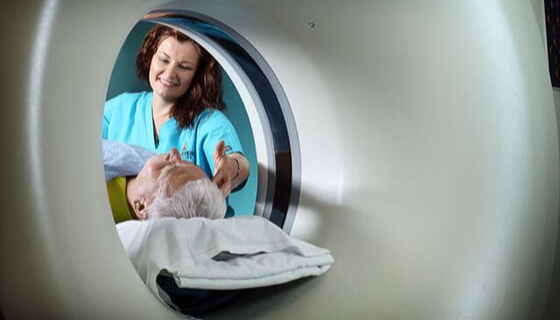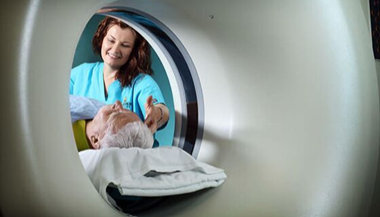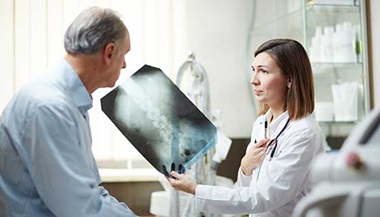Computed Tomography (CT or CAT) Scan of the Spine
What is a CT scan of the spine?
(Spinal CT Scan, CT of the Spine or Back)
Computed tomography (CT scan or CAT scan) is a noninvasive diagnostic imaging procedure that uses a combination of X-rays and computer technology to produce horizontal, or axial, images (often called slices) of the body. A CT scan shows detailed images of any part of the body, including the bones, muscles, fat, and organs. CT scans are more detailed than standard X-rays.
In standard X-rays, a beam of energy is aimed at the body part being studied. A plate behind the body part captures the variations of the energy beam after it passes through skin, bone, muscle, and other tissue. While much information can be obtained from a standard X-ray, a lot of detail about internal organs and other structures is not available.
In computed tomography, the X-ray beam moves in a circle around the body. This allows many different views of the same organ or structure. The X-ray information is sent to a computer that interprets the X-ray data and displays it in a two-dimensional (2D) form on a monitor.
CT scans may be done with or without "contrast." Contrast refers to a substance taken by mouth or injected into an intravenous (IV) line that causes the particular organ or tissue under study to be seen more clearly. Contrast examinations may require you to fast for a certain period of time before the procedure. Your physician will notify you of this prior to the procedure.
CT scans of the spine can provide more detailed information about the vertebrae (bones of the spine) and other spinal structures and tissues than standard X-rays of the spine, thus providing more information related to injuries and/or diseases of the spine.
Other related procedures that may be used to diagnose problems of the spine include X-rays , magnetic resonance imaging (MRI) of the spine , myelogram and positron emission tomography (PET) scan of the spine.
.png?h=283&iar=0&mh=360&mw=520&w=220&hash=B3CAF874F1168E5F00FE1D46E0D20357)
Anatomy of the spine
The spinal column is made up of 33 vertebrae that are separated by spongy disks and classified into distinct areas.
-
The cervical area consists of seven vertebrae in the neck.
-
The thoracic area consists of 12 vertebrae in the chest area.
-
The lumbar area consists of five vertebrae in the lower back area.
-
The sacrum has five, small fused vertebrae.
-
The four coccygeal vertebrae fuse to form one bone, called the coccyx or tailbone.
The spinal cord, a major part of the central nervous system, is located in the vertebral canal and reaches from the base of the skull to the upper part of the lower back. The spinal cord is surrounded by the bones of the spine and a sac containing cerebrospinal fluid. The spinal cord carries sense and movement signals to and from the brain and controls many reflexes.
What are the reasons for a CT scan of the spine?
A CT scan of the spine may be performed to assess the spine for a herniated disk, tumors and other lesions, the extent of injuries, structural anomalies such as spina bifida (a type of congenital defect of the spine), blood vessel malformations, or other conditions, particularly when another type of examination, such as X-rays or physical examination, is not conclusive. CT of the spine may also be used to evaluate the effects of treatment of the spine, such as surgery or other therapy.
There may be other reasons for your physician to recommend a CT scan of the spine.
What are the risks of a CT scan?
You may want to ask your physician about the amount of radiation used during the CT procedure and the risks related to your particular situation. It is a good idea to keep a record of your past history of radiation exposure, such as previous CT scans and other types of X-rays, so that you can inform your physician. Risks associated with radiation exposure may be related to the cumulative number of X-ray examinations and/or treatments over a long period of time.
If you are pregnant or suspect that you may be pregnant, you should notify your physician. Radiation exposure during pregnancy may lead to birth defects. If it is necessary for you to have a CT of the spine, special precautions will be made to minimize the radiation exposure to the fetus.
Nursing mothers should wait 24 hours after contrast material is injected before resuming breastfeeding.
If contrast media is used, there is a risk for allergic reaction to the media. Patients who are allergic to or sensitive to medications should notify their physician. Studies show that 85 percent of the population will not experience an adverse reaction from iodinated contrast; however, you will need to let your physician know if you have ever had a reaction to any contrast media, and/or any kidney problems. A reported seafood allergy is not considered to be a contraindication for iodinated contrast.
Patients with kidney failure or other kidney problems should notify their physician. In some cases, the contrast media can cause kidney failure. The effects of kidney disease and contrast agents have attracted increased attention over the last decade, as patients with kidney disease are more prone to kidney damage after contrast exposure. Also, patients taking the diabetes medication metformin (Glucophage) should alert their doctor before having IV contrast, as it may cause a rare condition called metabolic acidosis. If you take metformin, you will be asked to stop taking it at the time of the procedure and then wait for 48 hours after your injection. A blood test to check kidney function may be required before you can start taking metformin again.
There may be other risks depending upon your specific medical condition. Be sure to discuss any concerns with your physician prior to the procedure.
How do I prepare for a CT scan?
If you are having a computed tomography angiography (CTA) with Johns Hopkins radiology, you will be given specific instructions when you make your appointment.
PRECAUTIONS : If you are pregnant or think you may be pregnant, please check with your doctor before scheduling the exam. Other options will be discussed with you and your doctor.
CLOTHING : You may be asked to change into a patient gown. If so, a gown will be provided for you. A locker will be provided to secure personal belongings. Please remove all piercings and leave all jewelry and valuables at home.
CONTRAST MEDIA : CT scans are most frequently done with and without a contrast media. The contrast media improves the radiologist's ability to view the images of the inside of the body.
-
Some patients should not have an iodine-based contrast media. If you have problems with your kidney function, please inform the access center representative when you schedule the appointment. You may be able to have the scan performed without contrast media or have an alternative imaging exam.
-
You will be asked to sign a consent form that will detail the risks and side-effects associated with contrast media injected through a small tube places in a vein called an intravenous (IV) line.
-
The most common type of CT scan with contrast is the double contrast study that will require you to drink a contrast media before your exam begins in addition to the IV contrast. The more contrast you are able to drink, the better the images are for the radiologist to visualize your digestive tract.
ALLERGY : Please inform the access center representative when you schedule your CT scan if you have had an allergic reaction to any contrast media. IV contrast will not be administered if you have had a severe or anaphylactic reaction to any contrast media in the past. If you had mild to moderate reactions in the past, you will likely need to take medication prior to the CT scan. These plans will be discussed with you in detail when you schedule your exam. Any known reactions to a contrast media should be discussed with your personal physician.
EAT/DRINK : If your doctor ordered a CT scan without contrast, you can eat, drink and take your prescribed medications prior to your exam. If your doctor ordered a CT scan with contrast, do not eat anything three hours prior to your CT scan. You are encouraged to drink clear liquids. You may also take your prescribed medications prior to your exam.
DIABETICS : Diabetics should eat a light breakfast or lunch three hours prior to the scan time. Depending on your oral medication for diabetes, you may be asked to discontinue use of the medication for 48 hours after the CT scan. If you have a CT scan with Johns Hopkins radiology, detailed instructions will be given following your examination.
MEDICATION : All patients can take their prescribed medications as usual.
Based on your medical condition, your doctor may request other specific preparation.
.png?h=265&iar=0&mh=360&mw=520&w=175&hash=57713E183F493BFF3F25019F51C27E11)
What happens during a CT scan?
CT scans may be performed on an outpatient basis or as part of your stay in a hospital. Procedures may vary depending on your condition and your physician's practices.
Generally, a CT scan follows this process:
-
You may be asked to change into a patient gown. If so, a gown will be provided for you. A locked will be provided to secure all personal belongings. Please remove all piercings and leave all jewelry and valuables at home.
-
If you are to have a procedure done with contrast, an intravenous (IV) line will be started in the hand or arm for injection of the contrast media. For oral contrast, you will be given a liquid contrast preparation to swallow. In some situations, the contrast may be given rectally.
-
You will lie on a scan table that slides into a large, circular opening of the scanning machine. Pillows and straps may be used to prevent movement during the procedure.
-
The technologist will be in another room where the scanner controls are located. However, you will be in constant sight of the technologist through a window. Speakers inside the scanner will enable the technologist to communicate with and hear you. You may have a call button so that you can let the technologist know if you have any problems during the procedure. The technologist will be watching you at all times and will be in constant communication.
-
As the scanner begins to rotate around you, X-rays will pass through the body for short amounts of time. You will hear clicking sounds, which are normal.
-
The X-rays absorbed by the body's tissues will be detected by the scanner and transmitted to the computer. The computer will transform the information into an image to be interpreted by the radiologist.
-
It will be important that you remain very still during the procedure. You may be asked to hold your breath at various times during the procedure.
-
If contrast media is used for your procedure, you may feel some effects when the media is injected into the IV line. These effects include a flushing sensation, a salty or metallic taste in the mouth, a brief headache, or nausea and/or vomiting. These effects usually last for a few moments.
-
You should notify the technologist if you feel any breathing difficulties, sweating, numbness or heart palpitations.
-
When the procedure has been completed, you will be removed from the scanner.
-
If an IV line was inserted for contrast administration, the line will be removed.
While the CT procedure itself causes no pain, having to lie still for the length of the procedure might cause some discomfort or pain, particularly in the case of a recent injury or invasive procedure such as surgery. The technologist will use all possible comfort measures and complete the procedure as quickly as possible to minimize any discomfort or pain.
What happens after a CT scan?
If contrast media was used during your procedure, you may be monitored for a period of time for any side effects or reactions to the contrast media, such as itching, swelling, rash, or difficulty breathing. Notify the radiologist or your physician if you experience any of these symptoms.
If you notice any pain, redness, and/or swelling at the IV site after you return home following your procedure, you should notify your physician as this could indicate an infection or other type of reaction.
Otherwise, there is no special type of care required after a CT scan of the spine. You may resume your usual diet and activities unless your physician advises you differently.
Your physician may give you additional or alternate instructions after the procedure, depending on your particular situation.




